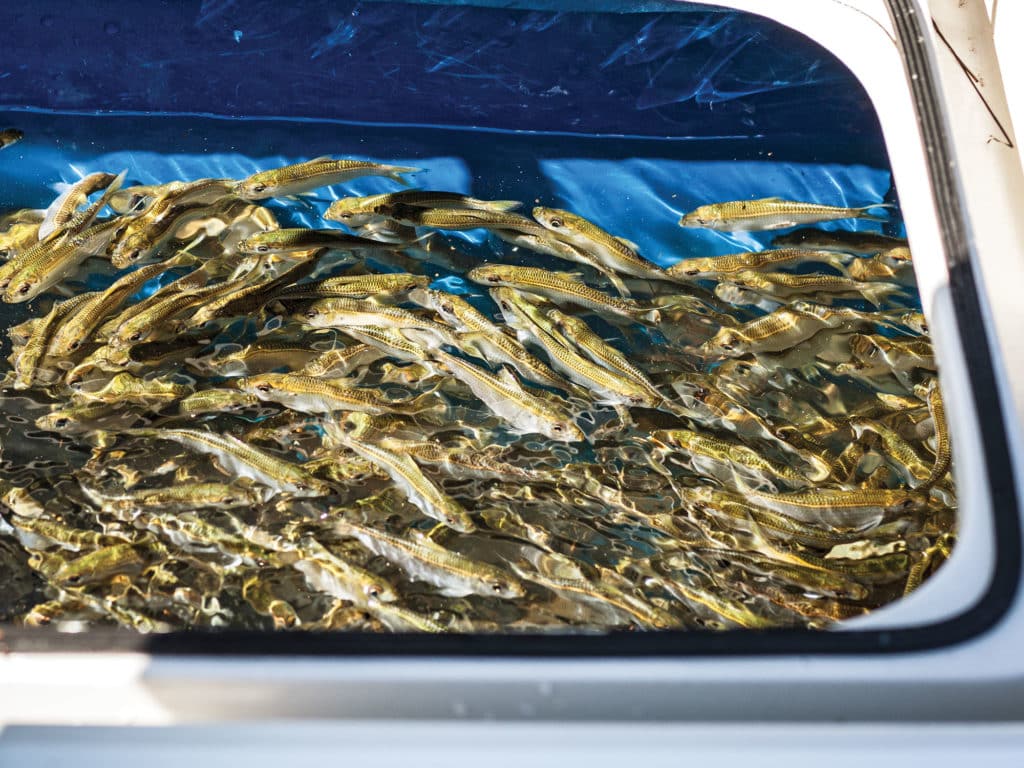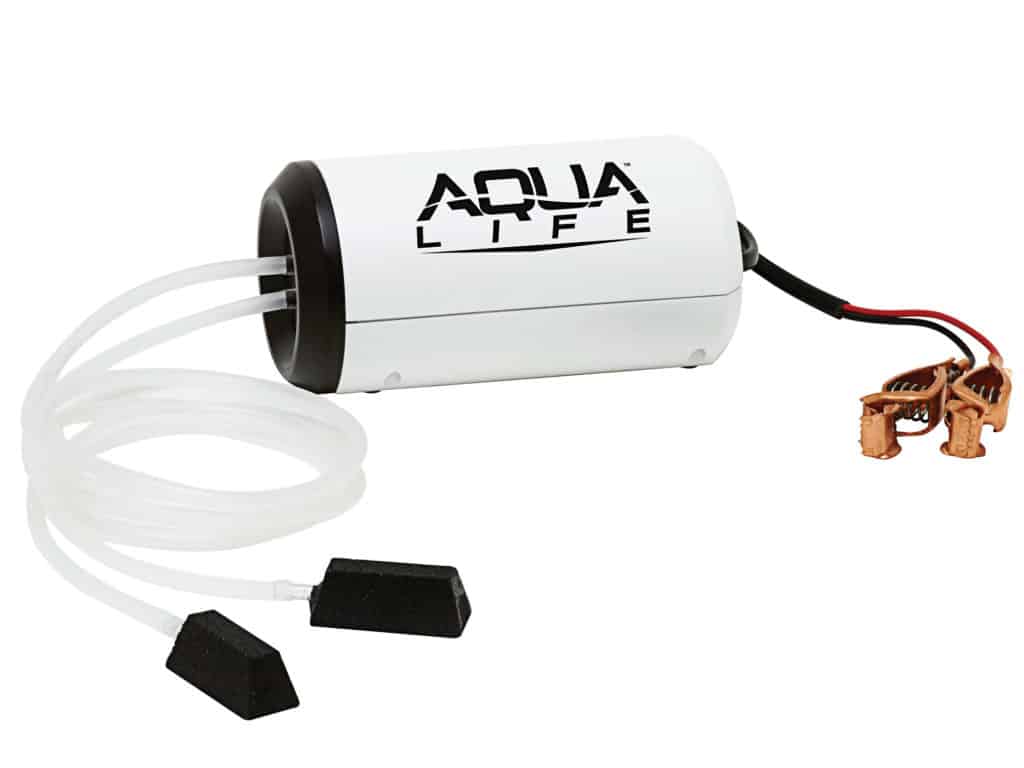
HIGH DEMAND
Guides, tournament contestants and inshore anglers who depend on lively bait or must bring their catch alive to the weigh-in can’t afford to take chances.
For them, modifying a boat’s livewell system to inject more oxygen is a must. But a better understanding of biology and a little customizing let anyone benefit from an upgraded aeration system.
Aeration Variations
“There are several factors that come into play for an effective livewell system,” says Capt. Mark Benson of Orlando, Florida, who worked for 14 years as an analyst for Pentair Aquatic Eco-Systems, a leading aquaculture supplier, before becoming a guide. “Fish excrete ammonia through their waste, skin and breathing. Different species also use oxygen at different levels. For instance, a redfish you hold in the well for a tournament weigh-in requires less oxygen than a full load of delicate, fast-swimming pilchards.” The frisky baitfish doing laps in the livewell have faster metabolisms than the considerably larger red with restricted mobility.
“A livewell system is based on biomass (how many pounds of fish it holds). It must satisfy the oxygen demands and flush out the ammonia buildup,” Benson adds. An air bubble only transfers so much oxygen to the water, he says. The percentage increases with water depth, since molecules have more time to separate while rising to the surface.
Temp Factor
Water temperature is another important factor. Warmer water holds less oxygen and also speeds up a fish’s metabolism, limiting the capacity of a livewell. But too many big bubbles or too much water pressure is not helpful either, since the oxygen molecules collide and don’t dissipate as much.
Baits forced to constantly fight a strong flow are more stressed and use more oxygen. Instead, it’s better to constantly replace the water in the well with fresh, cool seawater — to reduce the ammonia and lower the temperature — and inject small bubbles that add oxygen more efficiently.

Recirc Mode
Shrimp, crabs and less-active baitfish, like finger mullet, pinfish and mud minnows (killifish), use little oxygen, so most stock livewell pumps are adequate. If you carry large numbers of pilchards or sardines, however, or compete in live-release-format tournaments, you better opt for pumps with flow capacities of 750 gph or greater.
And always fill the well with the same seawater from where the bait was taken. If the water is hot or nasty, it pays to have a recirculating mode in your aeration system so you can switch to it until cooler, cleaner water is available to replenish the livewell.
Tiny Bubbles
Optional bubbler systems that include air stones or diffusers generate the desired tiny bubbles that release more oxygen into the water. Diffusers are rated by size and capacity (cubic feet per minute). A 12-inch diffuser in a 4-foot-deep well generates enough oxygen for 100 pounds of fish. Reduce that depth to 1 foot, and the same diffuser only produces enough oxygen for 25 pounds of fish. Multiple smaller diffusers spaced throughout the livewell offset any dead spots better than a single large one. “To keep fish or bait alive, especially in the summer heat when stress levels are higher, adding the right diffusers to a well is the most reliable solution and the best bang for the buck,” Benson says.
Capt. Jay Withers, a veteran southwest Florida guide and tournament angler, agrees. Withers has a 38-gallon livewell in the aft deck of his Pathfinder 2500 Hybrid and a second well — 25 gallons — housed in the leaning post. Both have pumps rated for 1,100 gph, and the larger well is also equipped with a Marine Metal Products 12-volt Power Bubbles with a doughnut air diffuser.
“In the winter, I mostly fish with shrimp and use just the bubbler because it’s quiet,” Withers explains. “During the summer, I often run two charters a day. Then, I fill both livewells with white bait (pilchards) and keep them alive all day so I don’t have to catch bait again for the second trip. Combining the bubbler and the pumps with the way I’ve set up the water jets, my livewell systems keep my bait healthy even when the water temperature gets above 85 degrees.”
Oxygen Boost
Withers also fishes as many as 15 redfish tournaments every year. When competing, he often adds pure oxygen to the livewell using a refillable oxygen bottle with a T-valve, which connects to a diffuser. Benson cautions that, while pure oxygen does increase the available level in the livewell enough to help redfish stay alive until they can be weighed, often several hours after capture, the conversion rate is inefficient and quickly adds to the operating costs.
Bear in mind, however, that too many bubbles are counterproductive. They often create foam or turn the water in the livewell milky — if the bubbles are tiny, making it difficult to keep tabs on your bait or tournament catch — and could even have a negative effect on the gills and eyes of certain baitfish.
Additives
Most live-weigh-in-format tournaments either impose substantial weight deductions for dead fish or disqualify them altogether. “In redfish tournaments, if you don’t come back in with live fish, it’s gonna cost ya,” Withers says. So, for extra insurance, he likes to add granular products like Rejuvenate or Redfish Saver to the water to keep redfish content until reaching the scale. The main ingredient in such additives is sodium chloride: plain old salt.
Timely Aeration
Livewell timers are a great way to keep baits frisky and save battery juice. Capt. Glyn Austin of Sebastian, Florida, has twin 37-gallon wells in the aft casting deck and a 16-gallon pitch well in the bow of his Wellcraft 221 Fisherman, and all three are equipped with pump timers. “With threadfins, pogies or sardines, I leave the pumps on constantly,” Austin explains. “For hardier baits like pigfish, pinfish, croakers and shrimp, I switch to auto mode, so the pumps run for one minute and shut down for two, and my batteries last longer. If I’m in depths of 18 inches or less, I switch to recirculating to avoid sucking in sand or mud; otherwise, I leave the valve open to keep fresh seawater replenishing the wells.”









